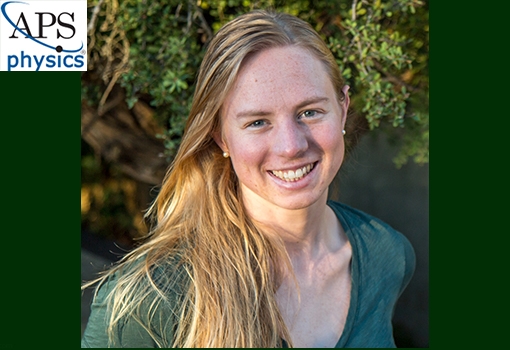Monday, March 16, 2020
Nicole Michenfelder-Schauser, a PhD student in the UC Santa Barbara Materials Department, has received the Frank J. Padden, Jr. Award, the nation’s most prestigious student polymer physics prize, from The American Physical Society. The annual award recognizes a single PhD student for excellence in polymer physics research, with judges basing their selection on the quality of nominees’ research, oral presentations during the Padden Award Symposium, and responses to questions.
“I am honored to receive the Padden Award. It was a very competitive field of finalists performing innovative research,” said Michenfelder-Schauser, who is co-advised by Rachel Segalman, professor and chair of the Chemical Engineering Department, and materials professor Ram Seshadri, director of the Materials Research Lab (MRL). “I think this award serves as continued validation of UCSB’s innovative and collaborative approach to materials research.”
Michenfelder-Schauser’s research centers on a relatively new class of materials called polymeric ionic liquids (PILS). These PILs are highly conductive, demonstrate thermal and chemical stability, and function in the absence of water, which allows them to operate in high temperatures and provide greater flexibility of design to incorporate a range of useful functions.
“Nicole has made huge contributions in efforts associated with polymeric ionic liquids,” said Seshadri. “Among her accomplishments is showing that mechanical properties can be decoupled from ion conduction, in contrast to conventional ion conducting polymers, where there is a mutual dependence on how rigid or soft the materials are, and how well they conduct ions. This has opened an important design space for new and useful materials, since ion conduction is so important for so many technologies.”
Motivated by maximizing energy efficiency and sustainability, Michenfelder-Schauser’s primary goal is to design materials, like next-generation polymer electrolytes, that can advance novel battery architectures. Her interest in using polymer physics as a solution for energy-storage applications started as an undergraduate at UC Berkeley, and has expanded during her time as a graduate student at UCSB, as she now explores the connections among polymer structure, ion transport, and macroscopic properties.
“I created a model polymer platform though which I can systematically tune the various factors that may be important for governing ion transport in polymers,” Michenfelder-Schauser said. “Currently, Professor Segalman and I are collaborating with Mitsubishi Chemical and two additional research groups at UCSB to explore how we can further improve the performance of these polymer electrolytes to be used in lithium batteries.”
She is the first UCSB graduate student to receive the top student APS award since James Rogers won in 2012. Rogers, who earned his PhD in Materials Science, is now the founder and CEO of Apeel Sciences, Inc., which makes an edible plant-based coating that nearly doubles the shelf life of produce to which it is applied. The coating was named one of TIME’s best inventions of 2019.
“UCSB’s College of Engineering has many inspirational current and former graduates working on cutting-edge research and important technological advances,” Michenfelder-Schauser said. “It’s inspiring to work alongside and to cross paths with so many high-achieving and collaborative scientists.”
Michenfelder-Schauser received more exciting news this month. She and fellow Materials PhD student Andrew Rowberg were two of the 660 young scientists from 101 countries invited to attend this summer’s Lindau Nobel Laureate Meeting in Germany. The annual gathering provides students and postdoctoral scholars with the unique experience of meeting and learning from dozens of Nobel Laureates.
“This is an amazing opportunity to speak with an esteemed group of scientists, as well as to interact with my young scientist peers. I hope to learn from the wisdom of the Nobel Laureates, who have experienced both great triumph and intense struggles, and leave inspired by their success and continued passion for science,” she added.
Additional honors previously received by Michenfelder-Schauser include the MRL’s Kramer Prize in Materials and graduate research fellowships from the National Science Foundation. She attributed her recognitions to the vital roles played by her co-advisors.
“Professor Seshadri has been invaluable both in terms of scientific insight on my projects and for personal and professional growth, challenging and encouraging me to think deeply about what I want out of this PhD experience,” said Michenfelder-Schauser, who hopes to defend her PhD later this year. “Professor Segalman has provided me with tools to approach scientific problems in a methodical and productive way. She also acts as a strong female role model and mentor.”
Her co-advisors, in turn, directed credit for their student’s success back to Michenfelder-Schauser.
“Nicole is one of the most intellectually rigorous, creative, hard-working, and dedicated students either of us has had the pleasure to work with, teach, advise, or interact with over the last twenty years,” said Segalman. “She not only compares favorably with former members of our groups who have gone on to very creative and productive careers at top universities and industrial research laboratories, but in our opinions, she is possibly the strongest polymer or materials scientist we have worked with in any capacity.”
“Nicole has proven to be a careful and innovative scientist, a great collaborator, and a terrific mentor,” added Seshadri.
Still weighing her post-doctoral career options, Michenfelder-Schauser knows she wants to be in a position to impact society with her work, ideally focusing on environmental and materials sustainability.

Nicole Michenfelder-Schauser, Frank J. Padden, Jr. Award recipient

